Introduction
This bulletin provides information on volumes and sentence outcomes for adult offenders (aged 18 or over at the time of conviction) sentenced for offences covered by the Sentencing Council’s draft guidelines on the offences of aggravated vehicle taking and vehicle registration fraud. There are five draft guidelines covering the following offences:
- Aggravated vehicle taking causing vehicle or property damage not exceeding £5,000, Theft Act 1968 (section 12A(2)(c) and (d))
- Aggravated vehicle taking causing vehicle or property damage exceeding £5,000, Theft Act 1968 (section 12A(2)(c) and (d))
- Aggravated vehicle taking involving dangerous driving, Theft Act 1968 (section 12A(2)(a))
- Aggravated vehicle taking causing injury, Theft Act 1968 (section 12A(2)(b))
- Aggravated vehicle taking causing death, Theft Act 1968 (section 12A(2)(b))
- Vehicle registration fraud, Vehicle Excise and Registration Act 1994 (section 44)
There are existing Magistrates’ Court Sentencing Guidelines (MCSG) for the offences of aggravated vehicle taking (causing vehicle or property damage, injury and involving dangerous driving) and vehicle licence/registration fraud. There are no existing guidelines for these offences for use in the Crown Court. The Council has therefore produced new sentencing guidelines for these offences, for use at all courts.
A single draft aggravated vehicle taking guideline is proposed to cover circumstances where the damage caused does not exceed £5,000 and where the damage caused exceeds £5,000. The statistics are provided separately for these offences in this bulletin.
The data presented in the section ‘Aggravated vehicle taking causing injury’ do not include cases where a death was caused. Statistics on cases of aggravated vehicle taking where a death was caused are provided within the section ‘Aggravated vehicle taking causing death’.
The Court Proceedings Database (CPD), maintained by the Ministry of Justice, is the data source for this bulletin. For more information on this data source please see the ‘Further information’ section at the end of this document.
Additional figures for this offence, including breakdowns by demographic groups (sex, age group and ethnicity), can be found in the data tables which are available to download as Open Document spreadsheets on the Sentencing Council: Publications webpage.
There are known data issues within these statistics. In the CPD, there were a number of records for aggravated vehicle taking offences (not involving death) where the exact type of aggravated vehicle taking was unknown. Additionally, there were a number of cases for aggravated vehicle taking causing damage not exceeding £5,000 where the record indicates that the offender was sentenced at the Crown Court. This type of offence is summary only and there are only limited circumstances in which these cases would be sentenced in the Crown Court. The volumes of any cases recorded as sentenced at the Crown Court for damage not exceeding £5,000 and those where the exact type of aggravated vehicle taking was unknown both have been included in ‘Section 6: Aggravated vehicle taking, offence type unknown’ of the data tables (see Sentencing Council: Publications webpage). Thus, the actual volume of offenders sentenced for aggravated vehicle taking (not involving death) may be higher than the volumes presented in this bulletin.
Aggravated vehicle taking causing vehicle or property damage not exceeding £5,000
Sentence volumes
In 2022, around 370 adult offenders were sentenced for aggravated vehicle taking causing vehicle or property damage not exceeding £5,000 (see Figure 1). There has been a general decline in the volumes of offenders sentenced for this offence since 2012, with the last three years being relatively stable.
Figure 1: Number of adult offenders sentenced for aggravated vehicle taking causing vehicle or property damage not exceeding £5,000, 2012 to 2022
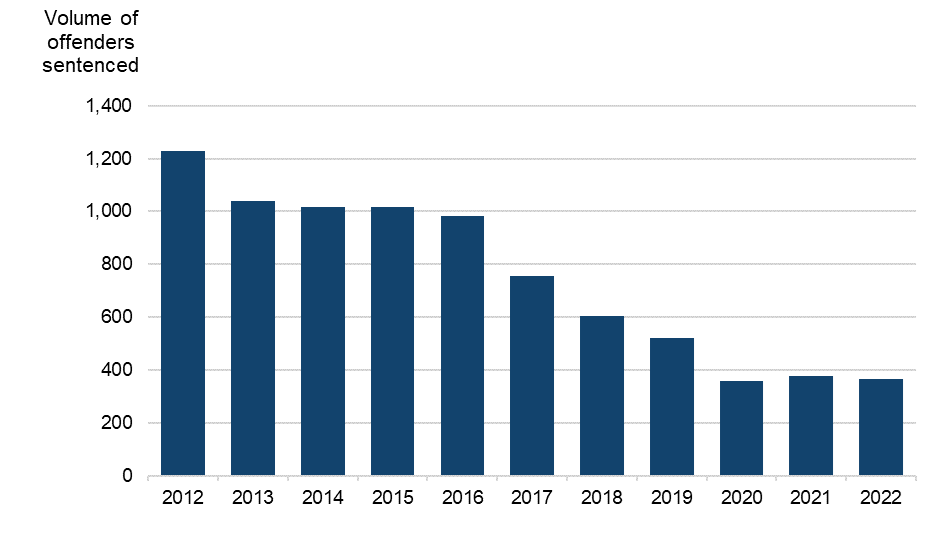
Sentence outcomes
The most common outcome for offenders sentenced for aggravated vehicle taking causing vehicle or property damage not exceeding £5,000 is consistently a community sentence. In 2022, over half of offenders received a community sentence (56 per cent). A further 16 per cent received immediate custody, 14 per cent received a suspended sentence, 7 per cent received a fine, and 3 per cent were ‘Otherwise dealt with’ (see the ‘Further information’ section). The remaining 2 per cent received an absolute or conditional discharge.
Sentence lengths
The maximum sentence that can be imposed for cases of aggravated vehicle taking where the damage caused does not exceed £5,000 is 6 months’ custody (i.e. the limit in the magistrates’ courts). The (mean) average custodial sentence length (ACSL) in 2022 was 3 months, after any reduction for guilty plea.
Aggravated vehicle taking causing vehicle or property damage exceeding £5,000
Sentence volumes
In 2022, around 160 adult offenders were sentenced for aggravated vehicle taking causing vehicle or property damage exceeding £5,000 (see Figure 2). There has been a general decline in the volume of offenders sentenced for this category of aggravated vehicle taking since 2017, when around 290 offenders were sentenced. Around two-thirds (66 per cent) of offenders were sentenced in the magistrates’ courts in 2022.
Figure 2: Number of adult offenders sentenced for aggravated vehicle taking causing vehicle or property damage exceeding £5,000, 2012 to 2022
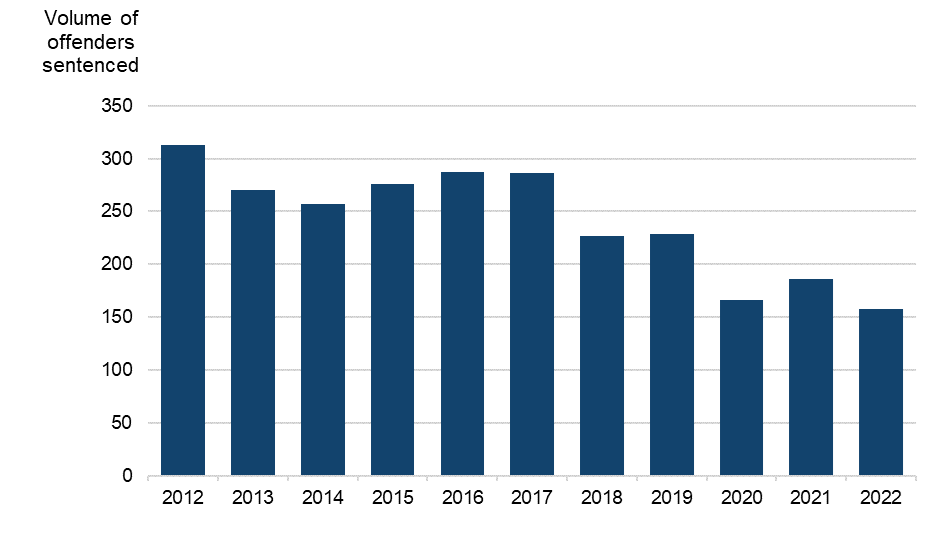
Sentence outcomes
Nearly half (46 per cent) of the offenders sentenced for aggravated vehicle taking causing vehicle or property damage exceeding £5,000 in 2022 received a community sentence. This has consistently been the most common outcome over the last 11 years. Around 25 per cent received a suspended sentence and 23 per cent received immediate custody. The remaining offenders received a fine (4 per cent), were ‘Otherwise dealt with’ (3 per cent) or received an absolute or conditional discharge (1 per cent).
Sentence lengths
The statutory maximum sentence for this offence is 2 years’ custody. In 2022, the ACSL was 9 months and all offenders sentenced to immediate custody received a sentence of 18 months or less.
Aggravated vehicle taking involving dangerous driving
Sentence volumes
In 2022, around 250 adult offenders were sentenced for aggravated vehicle taking involving dangerous driving. Since 2012, there has been a slight decline in the volumes of offenders sentenced for this type of aggravated vehicle taking, with volumes remaining relatively stable in the last five years (see Figure 3). Around three-quarters (76 per cent) of offenders were sentenced in the Crown Court in 2022.
Figure 3: Number of adult offenders sentenced for aggravated vehicle taking involving dangerous driving, 2012 to 2022
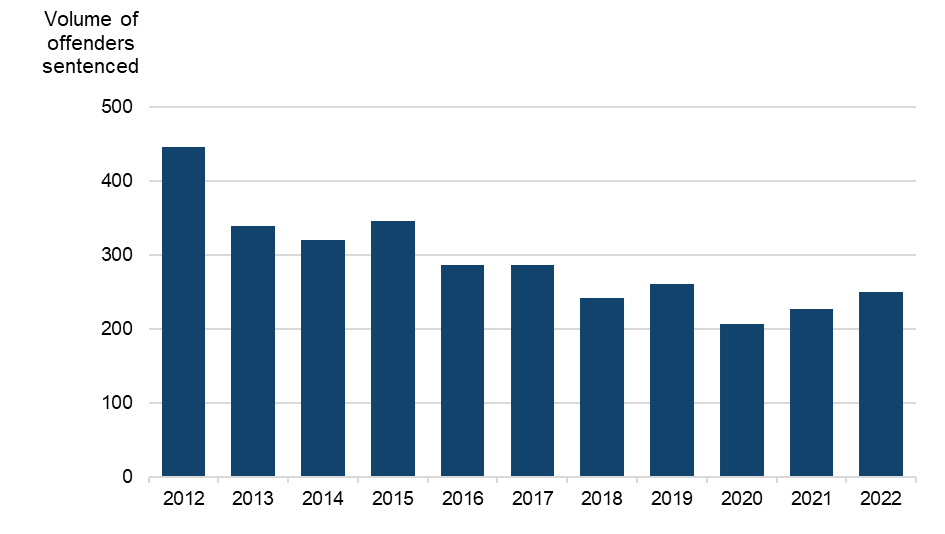
Sentence outcomes
The most common outcome for offenders sentenced for aggravated vehicle taking involving dangerous driving was immediate custody (around 47 per cent in 2022). A further 29 per cent received a suspended sentence, 19 per cent received a community sentence and 4 per cent were ‘Otherwise dealt with’. The remaining offenders received a fine (1 per cent), or an absolute or conditional discharge (fewer than 1 per cent).
Sentence lengths
The statutory maximum sentence for this offence is 2 years’ custody. The ACSL in 2022 was 10 months. All offenders sentenced to immediate custody in 2022 received a sentence of 18 months or less, after any reduction for a guilty plea.
Aggravated vehicle taking causing injury
Sentence volumes
In 2022, around 40 offenders were sentenced for aggravated vehicle taking causing injury (see Figure 4). The volume of offenders sentenced for this category of aggravated vehicle taking has generally decreased since 2014 when around 110 offenders were sentenced. There was an approximately even split in the proportion of offenders sentenced in the magistrates’ courts (51 per cent) and Crown Court (49 per cent).
Figure 4: Number of adult offenders sentenced for aggravated vehicle taking causing injury, 2012 to 2022
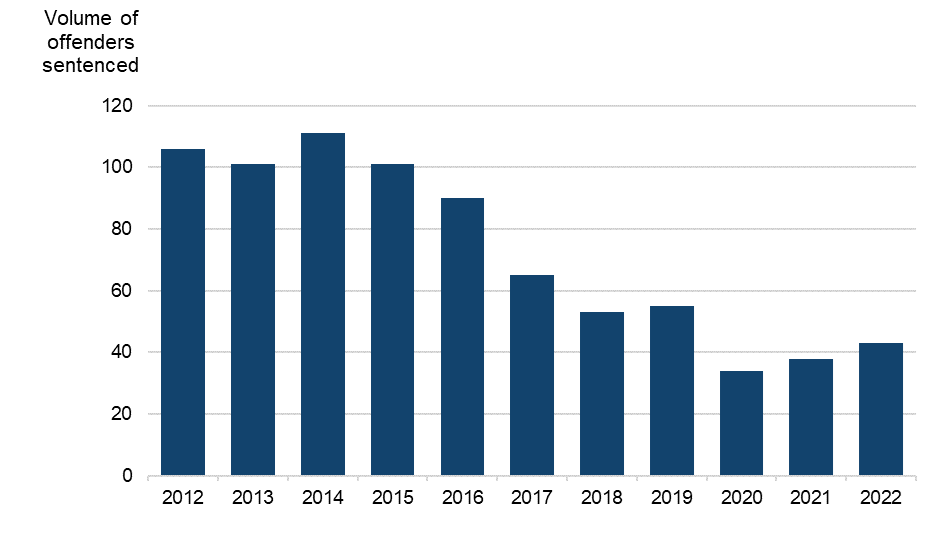
Sentence outcomes
In 2022, the most common outcome for offenders sentenced for aggravated vehicle taking causing injury was immediate custody (40 per cent), followed by a community sentence (30 per cent) and a suspended sentence (28 per cent). These proportions are generally similar to those seen in previous years. The remaining offenders were ‘Otherwise dealt with’ (2 per cent).
Sentence lengths
The statutory maximum sentence for this category of aggravated vehicle taking offence is 2 years’ custody (where death is not caused). The ACSL in 2022 was 8 months. All offenders sentenced to immediate custody in 2022 received a sentence of 18 months or less, after any reduction for guilty plea.
Aggravated vehicle taking causing death
Sentence volumes
Cases of aggravated vehicle taking causing death are very low volume and fewer than 5 offenders were sentenced in 2022. No offenders were recorded as sentenced from 2016 to 2018 (see Figure 5). In the last 11 years, all offenders were sentenced in the Crown Court.
Figure 5: Number of adult offenders sentenced for aggravated vehicle taking causing death, 2012 to 2022
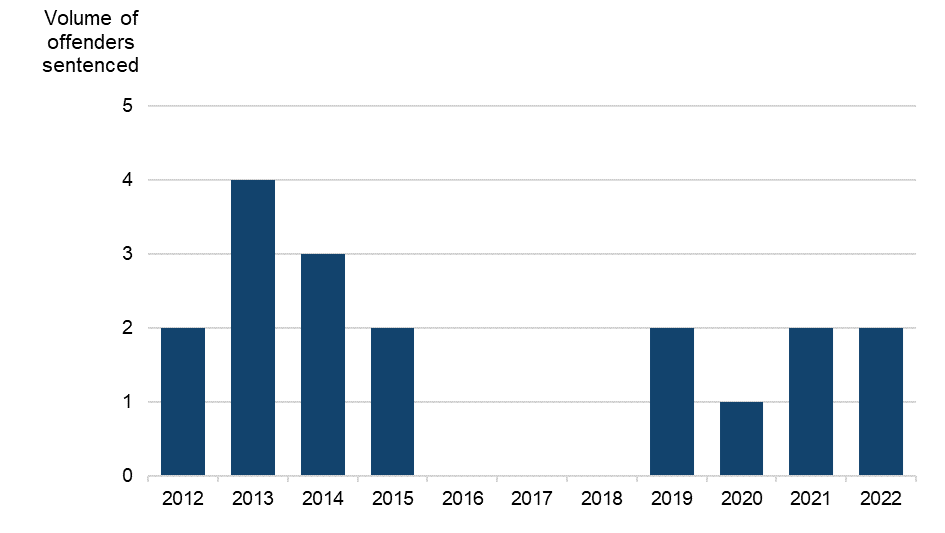
Sentence outcomes
In 2022, all offenders were sentenced to immediate custody, and this has generally been the only outcome for this offence in the last 4 years.
Sentence lengths
The statutory maximum sentence for aggravated vehicle taking causing death is 14 years’ custody. Due to the small volume of offenders sentenced each year, the ACSL has been calculated for the last five years combined. Over the period 2018 to 2022, the ACSL was 4 years 8 months.
Vehicle registration fraud
Sentence volumes
In 2022, around 160 offenders were sentenced for vehicle registration fraud which is the highest volume in the last 11 years. The volume of offenders sentenced for this offence has increased since 2016, when around 40 offenders were sentenced (see Figure 6). Around 65 per cent of offenders were sentenced in the magistrates’ courts in 2022. However, this proportion has notably decreased since 2014, when 93 per cent of offenders were sentenced in the magistrates’ courts.
Figure 6: Number of adult offenders sentenced for vehicle registration fraud, 2012 to 2022
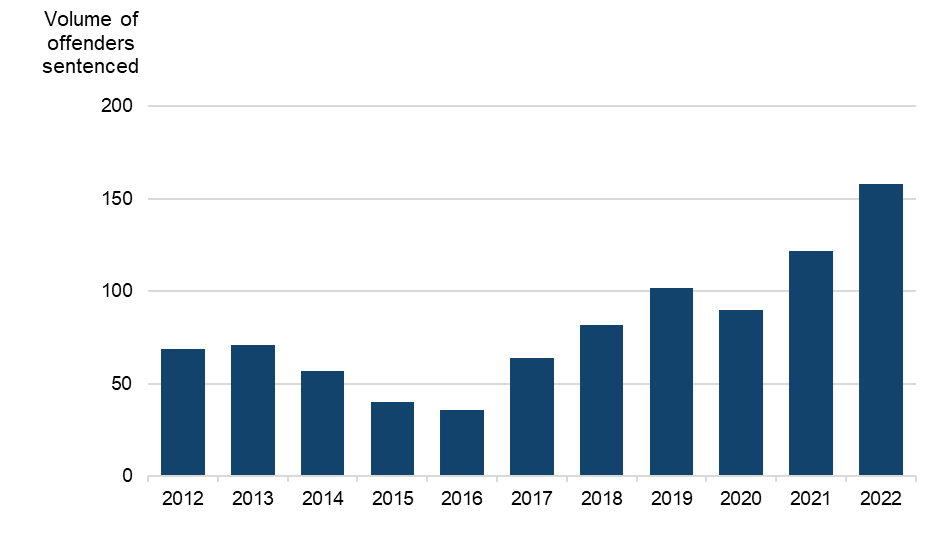
Sentence outcomes
In 2022, the most common outcome for offenders sentenced for vehicle registration fraud was a fine (60 per cent), followed by a suspended sentence (15 per cent), community sentence (10 per cent) and immediate custody (9 per cent). A further 4 per cent received an absolute or conditional discharge, and 1 per cent were ‘Otherwise dealt with’.
In 2022, offenders sentenced to a fine received an average (median) fine value of £150, after any reduction for a guilty plea. The majority of fines (64 per cent) were £200 or less.
Sentence lengths
The statutory maximum sentence for this offence is 2 years’ custody. Due to the small volumes of offenders receiving immediate custody each year, the ACSL has been calculated for the last five years combined. Over the period 2018 to 2022, the ACSL was 5 months.
Further information
Volumes of sentences
The data presented in this bulletin only include cases where the offence detailed was the principal offence committed. When an offender has been found guilty of two or more offences, the principal offence is the offence for which the heaviest penalty is imposed. Where the same disposal is imposed for two or more offences, the offence selected is the offence for which the statutory maximum penalty is the most severe. Although the offender will receive a sentence for each of the offences that they are convicted of, it is only the sentence for the principal offence that is presented in this bulletin.
Sentence outcomes
The outcomes presented are the final sentence outcomes, after taking into account all factors of the case, including whether a guilty plea was made. This is because the sentence length information available in the Court Proceedings Database (CPD) is the final sentence imposed, after any reduction for guilty plea. Sentence outcomes presented in this bulletin are therefore not directly comparable to outcomes in the sentencing guideline tables, which instead show starting point sentences before a guilty plea has been entered.
General conventions
Actual numbers of sentences have been rounded to the nearest 100, when more than 1,000 offenders were sentenced, and to the nearest 10 when fewer than 1,000 offenders were sentenced.
Proportions of sentencing outcomes have been rounded to the nearest integer. Percentages in this report may not appear to sum to 100 per cent, due to rounding.
Data sources and quality
The CPD, maintained by the Ministry of Justice (MoJ), is the data source for these statistics. Every effort is made by MoJ and the Sentencing Council to ensure that the figures presented in this publication are accurate and complete. However, it is important to note that these data have been extracted from large administrative data systems generated by the courts and police forces. As a consequence, care should be taken to ensure data collection processes and their inevitable limitations are taken into account when those data are used.
Further details of the processes by which MoJ validate the records in the CPD can be found inside the ‘Technical Guide to Criminal Justice Statistics’ within the Criminal Justice System Statistics Quarterly (CJSQ) publication.
The data in this report were generated using the Ministry of Justice’s (MoJ) Court Proceedings Database (CPD), aligning with figures published in the Criminal Justice System statistics quarterly: December 2022 publication (CJSQ) which was originally published in May 2023. Since then, the CJSQ publication has been revised to reflect changes to the underlying data, which have not been reflected in these statistics. As such, the latest MoJ published statistics will not match the statistics in this report. Further information on changes to MoJ’s data processing can be found in the changes and revisions section of the latest publication.
The average custodial sentence lengths (ACSLs) presented in this bulletin are mean average custodial sentence length values for offenders sentenced to determinate custodial sentences, after any reduction for guilty plea.
‘Otherwise dealt with’ covers miscellaneous disposals. Please note that due to a data issue currently under investigation, there are a number of cases which are incorrectly categorised in the CPD as ‘Otherwise dealt with’. Therefore, these volumes and proportions should be treated with caution.
Figures presented include the time period from March 2020 in which restrictions were initially placed on the criminal justice system due to the coronavirus (COVID-19) pandemic, and the ongoing courts’ recovery since. It is therefore possible that these figures may reflect the impact of the pandemic on court processes and prioritisation and the subsequent recovery, rather than a continuation of the longer-term series, so care should be taken when interpreting these figures.
Contact points for further information
We would be very pleased to hear your views on our statistical bulletins. If you have any feedback or comments, please send them to: research@sentencingcouncil.gov.uk
Responsible Statistician: Sharmi Nath
Press Office enquiries: Kathryn Montague Tel: 020 7071 5792
Further information on the Sentencing Council and its work can be found on the Sentencing Council webpage.